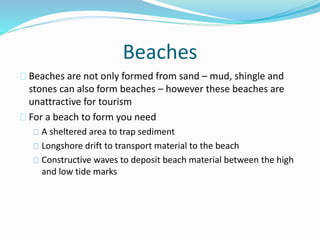Coastal processes
- 3. Waves Waves are one of the most powerful processes shaping our coast The power of waves is influenced by the strength of wind and by the fetch, the length of water the wave travels over before hitting land The fetch on the west coast of Ireland is obviously a lot bigger than the fetch on the east coast Bigger fetch = more powerful waves = more eroded coastline One glance at the Irish coast tells us which coast suffers more from erosion http://www.marine.ie/home/publicationsdata/data/buoys/
- 5. Swash and Backwash – p 158 Swash – the rush of water up a beach after a wave breaks (powerful) Backwash – the returning water to the sea (less powerful) Constructive Waves – Break gently, far from shore and swash pushes material into shore, very weak backwash Destructive Waves – Break very close to shore, very powerful backwash
- 6. Processes of Erosion Hydraulic action – power of water (waves) Abrasion – Rocks/sand thrown against the coast Compressed Air – trapped in small crevices in the rock by waves, this causes mini “explosions” which eventually shatter the rock Attrition – Rocks wearing off each other Solution – Salts in seawater dissolving rock (esp sedimentary rock) Wave refraction – waves bending on contact with the coast, concentrating it’s effects in certain areas
- 7. Processes of Deposition & transport This requires three basic conditions Gently sloping beaches to reduce wave energy Shelter from strong winds/currents (e.g. in a Bay) Constructive waves For Transport, the main process is Longshore Drift, also known as Littoral drift
- 9. Landforms of Erosion Cliffs and Wave Cut Platforms (Cliffs of Moher) Bays and Headlands (Dublin Bay, Bray Head) Sea Caves(Cliffs of Moher) Sea Arches (Old Head of Kinsale) Sea Stacks (Dun Briste, Co. Mayo) Sea Stumps (Cliffs of Moher)
- 10. Cliffs and Wave Cut Platforms
- 11. Cliffs of Moher
- 12. Cliffs of Moher
- 13. Cliffs and Wave Cut Platforms – P161
- 14. Bays and Headlands – p 163
- 15. Bays and Headlands Hard Rock – Erodes Slowly Soft Rock – Quickly Eroded
- 16. Sea Cave – p164
- 17. Cliffs of Moher Sea Cave Sea Stump
- 18. Sea Arch – p164
- 19. Sea Stack – Dun Briste, Co. Mayo
- 20. Blow Hole
- 21. Coastal Deposition Whatever gets eroded from one area on the coast eventually gets deposited in another area – nature always balances the books The rate of erosion also affects the rate of deposition – an area with mostly hard rock (e.g. Granite) will erode slowly and thus have little material for deposition Coastal deposition features (e.g. beaches) often have important economic benefits such as tourism
- 22. Beaches Beaches are not only formed from sand – mud, shingle and stones can also form beaches – however these beaches are unattractive for tourism For a beach to form you need A sheltered area to trap sediment Longshore drift to transport material to the beach Constructive waves to deposit beach material between the high and low tide marks
- 23. Storm Beach
- 24. Storm Beach
- 25. Storm Beach Backwash is too weak to drag stones back
- 26. Beach berm Berms
- 27. Cusps
- 28. Ripple Marks




























